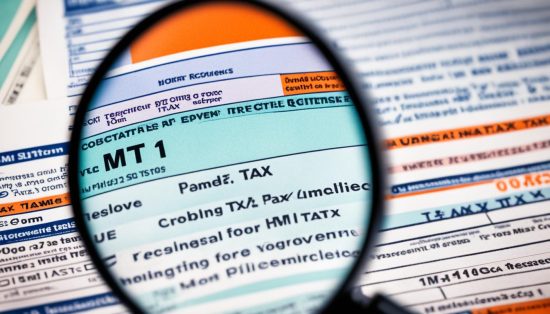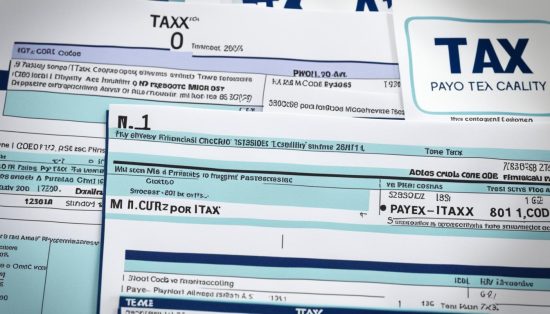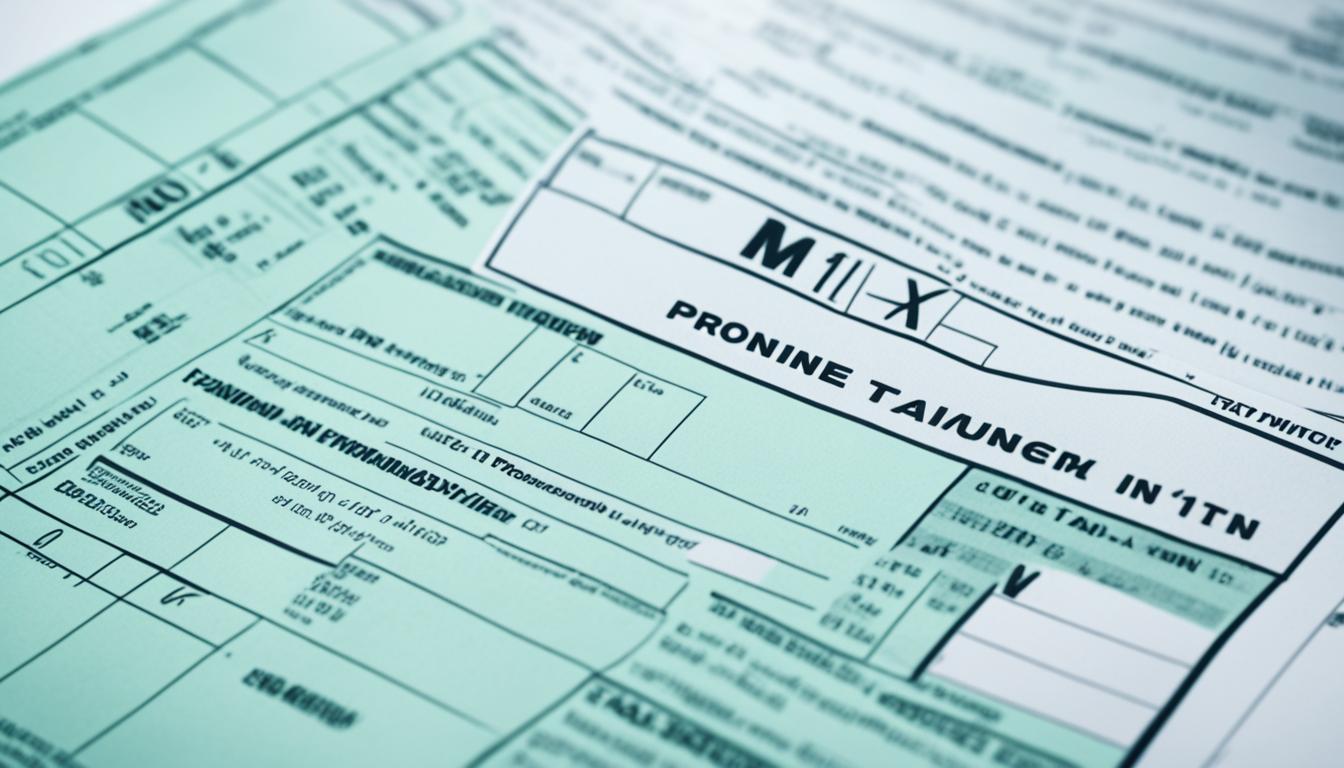The M1 tax code in the UK is an emergency tax code assigned by HMRC, the tax authority, when there is insufficient information to determine an individual’s correct tax code. This temporary and non-cumulative code applies when there has been a change in circumstances, such as starting a new job, transitioning from self-employment to employment, or receiving company benefits or the State Pension.
It is crucial to rectify any issues with your tax code to ensure you are paying the correct amount of tax. The M1 tax code does not consider any tax already paid in the tax year, so it is essential to provide HMRC with the necessary information to determine the correct tax code based on your specific circumstances.
By understanding the M1 tax code and its implications, you can ensure that you are not overpaying or underpaying your taxes. Stay informed about your tax allowance code and consult with HMRC or use online resources, such as tax code calculators, to review and update your tax code regularly.
How Does the M1 Tax Code Work?
The M1 tax code is an emergency tax code used in the UK to temporarily apply an emergency tax rate to an individual’s income. It is assigned by HMRC when they do not have enough information to determine the correct tax code. The M1 tax code does not take into account any tax already paid in the tax year, and it is non-cumulative, meaning it does not consider previous tax payments.
The M1 tax code works until HMRC receives the necessary information to determine the correct tax code based on the individual’s specific circumstances. It is deducted through the PAYE (Pay As You Earn) system, which means it is automatically deducted from the individual’s income by their employer.
To understand how the M1 tax code works, let’s break it down:
- The M1 tax code is assigned when HMRC lacks sufficient information to determine an individual’s correct tax code.
- It temporarily applies an emergency tax rate to the individual’s income.
- It does not consider any tax already paid in the tax year.
- The tax code is non-cumulative and does not take into account previous tax payments.
- The emergency tax rate is deducted through the PAYE system.
This table provides a summary of how the M1 tax code works:
| Tax Code | Calculation |
|---|---|
| M1 | Temporarily applies an emergency tax rate to an individual’s income |
It is important for individuals to rectify any issues with their tax code to ensure they are paying the correct amount of tax. Keeping track of any changes in circumstances and providing the necessary information to HMRC will help determine the correct tax code.
Who is Eligible for M1 Tax Code?
The M1 tax code is assigned to individuals in the UK who have recently experienced a change in circumstances. This change could include starting a new job, transitioning from self-employment to employment, or receiving company benefits or the State Pension. The M1 tax code is temporary and is used until HMRC receives the necessary information to determine the correct tax code based on the individual’s specific circumstances.
If you have recently started a new job, you may be assigned the M1 tax code until your employer provides the necessary details to HMRC. Similarly, if you have transitioned from self-employment to employment, the M1 tax code may be used until your tax situation is clarified. Additionally, if you are receiving company benefits or the State Pension, the M1 tax code may be assigned until HMRC receives the relevant information.
It is important to note that the M1 tax code is temporary and should not be considered as a permanent tax code. Once HMRC has the necessary information, they will update your tax code accordingly. It is crucial to keep HMRC informed of any changes in your circumstances, such as changes in employment or eligibility for company benefits or the State Pension, to ensure that your tax code remains accurate.
If you are unsure about your eligibility for the M1 tax code or have any questions about your tax code, you can contact HMRC directly or consult a tax professional for guidance.
Benefits of M1 Tax Code
The M1 tax code offers several benefits to individuals who find themselves on this temporary emergency tax rate. By allowing individuals to continue working and earning income while HMRC resolves any issues with their tax code, it ensures a smooth continuation of work and income flow.
Despite being on an emergency tax rate, individuals can still receive their income until the correct tax code is determined. This temporary arrangement ensures that individuals can maintain financial stability during the period of adjustment.
The benefits of the M1 tax code include:
- Continued income: The M1 tax code allows individuals to receive their income, even though it may be subject to an emergency tax rate. This enables individuals to meet their financial obligations and maintain their standard of living.
- Work continuity: By allowing individuals to continue working while any necessary adjustments are made to their tax code, the M1 tax code ensures that employment arrangements can proceed uninterrupted. This is particularly important for individuals who rely on regular income for their livelihood.
- Smooth transition: When there has been a change in circumstances, such as starting a new job or receiving company benefits, the M1 tax code provides a temporary solution while HMRC updates the individual’s tax code. This allows for a seamless transition without significant disruptions.
Overall, the M1 tax code provides temporary relief and ensures individuals can continue earning income during the resolution of any tax code issues. While the emergency tax rate may temporarily affect net pay, it offers the necessary support for financial stability until the correct tax code is determined.

Key Benefits of the M1 Tax Code
| Benefits | Description |
|---|---|
| Continued income | Individuals can still receive their income, albeit at an emergency tax rate, providing financial stability during the tax code adjustment period. |
| Work continuity | The M1 tax code allows individuals to continue working and earning income, ensuring minimal disruptions to employment arrangements. |
| Smooth transition | For individuals experiencing a change in circumstances, the M1 tax code offers a temporary solution while HMRC updates their tax code, facilitating a seamless transition. |
Reasons for Having a M1 Tax Code in the UK
The M1 tax code is assigned to individuals in the UK for emergency purposes when HMRC does not have enough information to determine their correct tax code. There are several reasons why individuals may have an M1 tax code:
- Change in Circumstances: When an individual’s circumstances change, such as starting a new job, transitioning from self-employment to employment, or receiving company benefits or the State Pension, HMRC may assign an M1 tax code temporarily.
- Starting a New Job: When an individual starts a new job, HMRC may not have all the necessary information about their income and tax history. As a result, they are assigned an M1 tax code until HMRC receives the required details.
- Transition from Self-Employment to Employment: If an individual switches from being self-employed to being an employee, their tax circumstances change. Until HMRC receives the updated information, they may assign an M1 tax code to ensure tax deductions are made.
- Receiving Company Benefits: When individuals receive company benefits, such as a company car or private health insurance, HMRC may assign an M1 tax code temporarily as they assess the tax implications of these benefits.
- State Pension: Individuals who start receiving the State Pension may have their tax code adjusted to reflect this change. Until HMRC processes the pension details, they may assign an M1 tax code to ensure the correct deductions are made.
By assigning the M1 tax code, HMRC allows individuals to continue working and earning income while they resolve any issues and determine the correct tax code. This ensures that individuals can maintain their financial stability during the transitional period.
It’s crucial to keep HMRC informed about any changes in circumstances to ensure that the correct tax code is assigned, and the appropriate deductions are made. Updating the tax code promptly ensures accurate tax calculations and prevents over or underpayment of taxes.

Example of PAYE on M1 Tax Code
An example of how PAYE (Pay As You Earn) works on the M1 tax code is when an individual earns income while on the emergency tax code (m1 tax code). In this scenario, the employer automatically deducts tax from the individual’s income at the emergency tax rate (emergency tax rate). It is important to note that the emergency tax rate is typically higher than the regular tax rate.
The purpose of this higher tax rate is to ensure that tax payments are still made, albeit at a higher rate, while HMRC determines the correct tax code for the individual. By deducting tax at the emergency tax rate, the employer ensures that taxes are being paid, even though it may not be at the rate that would apply to their regular tax code (PAYE).

This example showcases the temporary nature of the M1 tax code and the emergency tax rate. It allows individuals to continue earning income while their correct tax code is being determined. Once the correct tax code is established, the individual’s employer will adjust the tax deductions accordingly, ensuring that the appropriate amount of tax is paid moving forward.
How to Apply M1 Tax Code in the UK?
When facing a change in circumstances that would result in HMRC lacking sufficient information to determine your correct tax code, the M1 tax code is automatically applied in the UK. Individuals do not need to specifically apply for the M1 tax code. However, it is crucial to ensure that any changes in circumstances, such as starting a new job or receiving company benefits, are promptly communicated to HMRC. This communication is essential for the assignment of the correct tax code.

Ensuring the application of the M1 tax code is as simple as informing HMRC about your change in circumstances. This includes providing details about the relevant changes, such as a new job or the start of receipt of company benefits. By proactively communicating these changes, you can ensure that your tax code is up-to-date.
Updating your tax code is essential to avoid any potential issues with incorrect tax deductions. By promptly informing HMRC about changes in your circumstances, you can prevent over- or underpayment of taxes. This proactive approach helps ensure that you are paying the correct amount of tax, based on your specific situation.
Remember, keeping your tax code accurate is not only beneficial for proper tax payment but also avoids any potential penalties or unnecessary complications. Take the necessary steps to keep HMRC informed about any changes in your circumstances to update your tax code and maintain compliance.
How to Check and Update Your M1 Tax Code?
To ensure that your tax code is accurate and up to date, follow these steps to check and update your M1 tax code:
- Use the online tax code service provided by HMRC. This service allows you to view your current tax code and make any necessary updates. Simply visit the HMRC website and follow the instructions provided.
- Contact HMRC directly. If you prefer to speak to someone directly, you can contact HMRC’s helpline and inquire about your tax code. They will be able to provide you with guidance and assistance.
- Consult your employer. Your employer should also have access to your tax code information. Reach out to your employer’s HR or payroll department to ensure that your tax code is accurate. They can help you update your tax code if needed.
- If you have recently started a new job, provide your employer with a P45 from your previous job. This document contains important information about your previous income and tax payments, which can help your new employer calculate the correct tax code.
- If you have transitioned from self-employment to employment, your employer should provide you with a starter checklist. This checklist will ask for details about your previous self-employment, such as income and expenses, which will help determine the appropriate tax code.
By taking these steps, you can ensure that your M1 tax code is accurate and reflect your current circumstances. Keeping your tax code up to date is essential to avoid any issues with incorrect tax deductions.
Why is it important to keep your tax code up to date?
Updating your tax code is crucial to avoid any discrepancies in the amount of tax deducted from your income. If your tax code is incorrect, you may end up paying too much or too little tax.
By regularly checking and updating your tax code, you can ensure that you are paying the correct amount of tax based on your current employment and financial circumstances. This helps you avoid unexpected tax bills or missing out on any tax reliefs or allowances you may be entitled to.
Additionally, keeping your tax code up to date ensures compliance with HMRC regulations and helps maintain accurate records of your income and tax payments.
Conclusion
The M1 tax code in the UK is an emergency tax code that is temporary and used when HMRC does not have enough information to determine an individual’s correct tax code. It is important to keep track of any changes in your tax code and ensure that it accurately reflects your circumstances.
By keeping your tax code up to date, you can avoid any issues with incorrect tax deductions. If you have any concerns or questions about your tax code, you can consult HMRC or use online resources, such as tax code calculators, to understand and review your tax code.
It is essential to stay informed about any tax code changes and updates to ensure that you are paying the correct amount of tax. HMRC regularly reviews and adjusts tax codes, and it is important to review your tax code letter carefully to understand any changes that may impact your tax allowance code.
Understanding and managing your tax code is crucial for maintaining compliance with HMRC regulations and ensuring that you are not overpaying or underpaying your taxes. Stay informed, review your tax code regularly, and seek professional advice if needed to ensure that your tax affairs are up to date and accurate.




















No Comments
Leave a comment Cancel